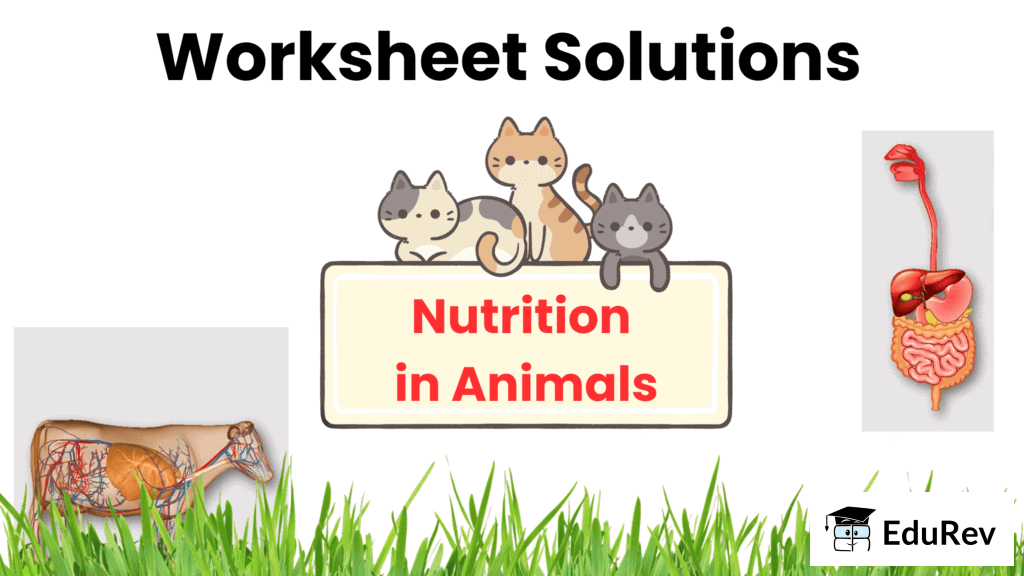Nutrition in Animals Class 7 Worksheet Science Chapter 2

Q.1. True/False
(i) Digestion of starch starts in the stomach.
False
(ii) The tongue helps in mixing food with saliva.
True
(iii) The gall bladder temporarily stores bile.
True
(iv) The ruminants bring back swallowed grass into their mouth and chew it for some time.
True
(v) We chew the food with the teeth and break it down mechanically into small pieces.
True
(vi) Large intestine receives digested and absorbed food.
False
Q.2. Fill in the blanks.
(i) The main steps of nutrition in humans are ____, ____, ____, ____ and ____.
ingestion, digestion, absorption, assimilation and egestion.
(ii) The largest gland in the human body is ____.
liver
(iii) The stomach releases hydrochloric acid and ____ juices which act on food.
digestive
(iv) The inner wall of the small intestine has many finger-like outgrowths called ____.
villi
(v) Amoeba digests its food in the food ____.
vacuole
(vi) We chew the food with the ____ and break it down mechanically into small pieces.
teeth
Q.3. Where are fats digested in the body?
Fats are primarily digested in the small intestine.
Q.4. What kills bacteria that enter along with the juices to act?
The acid kills many bacteria that enter along with the juices to act. This process helps to maintain a safe environment for digestion and prevents the growth of harmful bacteria.
Q.5. Where are faeces formed in the human body?
Faeces are formed in the human body in large intestine.
Q.6. Where food is absorbed in our body?
Absorption of food takes place in small intestine.
Q.7. Where faeces are stored?
Faeces are stored in rectum.
Q.8. Name the end products of fats.
Fatty acids and Glycerol
Q.9. What is ingestion?
The process of taking food into the body is known as ingestion.
Q.10. What does saliva do to food in our mouth?
The saliva breaks down the starch into sugars.
Q.11. What is rumen?
Rumen is a large, sac-like structure found in ruminants, such as cattle and deer.
Q.12. What are permanent teeth?
The second set that replaces a temporary milk teeth are the permanent teeth.
Q.13. What does animal nutrition include?
Animal nutrition includes nutrient requirement, mode of intake of food and its utilisation in the body.
Q.14. What are the different modes of feeding in animals?
Different modes of feeding in animals include:
- Scraping - removing food from surfaces.
- Chewing - breaking down food into smaller pieces.
- Sucking - drawing in liquids, like nectar.
- Capturing and swallowing - catching prey whole.
- Filtering - sifting tiny food particles from water.
Q.15. What is diarrhoea?
Diarrhoea is a condition characterised by the frequent passage of watery stools. It can be caused by:
- Infections
- Food poisoning
- Indigestion
Q.16. What do you mean by assimilation?
The absorbed substances are transported through the blood vessels to various organs in the body. Here, they are used to create complex substances, such as the proteins essential for bodily functions. This process is known as assimilation.
Q.17. What are ruminant animals?
The grazing animals like cows, buffaloes and deer are known as ruminants.
Q.18. What do pancreatic juices digest?
The pancreatic juice plays a crucial role in digestion by acting on:
- Carbohydrates - breaking them down into simpler sugars.
- Fats - converting them into fatty acids and glycerol.
- Proteins - transforming them into amino acids.
Overall, pancreatic juice helps in simplifying these food components for better absorption in the body.
Q.19. What is cud?
Cud is a type of food that has been partially digested. It is returned from the stomach, specifically the rumen, of ruminant animals to their mouth for further chewing.
Q.20. What do you mean by rumination?
Rumination is a process that occurs in certain animals, known as ruminants. It involves the following steps:
- Animals quickly swallow their food, which is often grass.
- The food is stored in a part of the stomach called the rumen.
- Later, the partially digested food, known as cud, returns to the mouth.
- The animal then chews the cud thoroughly before swallowing it again.
This process helps in the digestion of tough plant materials, particularly cellulose, which many animals, including humans, cannot digest effectively.
|
111 videos|286 docs|28 tests
|
FAQs on Nutrition in Animals Class 7 Worksheet Science Chapter 2
| 1. What is the role of nutrients in animal nutrition? |  |
| 2. What are the different types of nutrients required by animals? |  |
| 3. How do animals obtain nutrients from their food? |  |
| 4. What is the importance of a balanced diet in animal nutrition? |  |
| 5. How do animals adapt their diet based on their nutritional needs? |  |

















